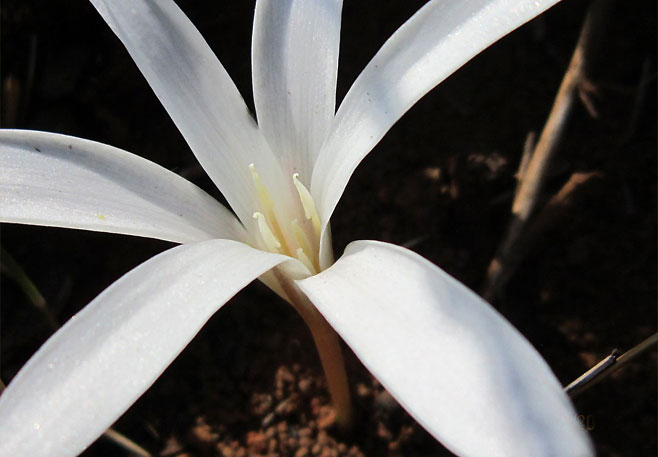Apodolirion buchananii (Natal
Crocus)
icukudwane, indwa [Zulu]
Life
> eukaryotes >
Archaeoplastida >
Chloroplastida
>
Charophyta > Streptophytina > Plantae (land plants)
> Tracheophyta (vascular plants) > Euphyllophyta > Lignophyta (woody plants)
> Spermatophyta (seed plants) > Angiospermae (flowering
plants)
> Monocotyledons > Order: Asparagales
> Family: Amaryllidaceae > Genus:
Apodolirion
 |
|
Apodolirion buchananii (Natal
Crocus), Karkloof rd, Howick, KwaZulu-Natal, South Africa. [image Peter R.
Warren ©, from
iNaturalist] |
Distribution and habitat
Recorded from South Africa (Eastern Cape, Free
State, KwaZulu-Natal, Mpumalanga) and Swaziland. Found scattered in
grassland; blooms after fire (Pooley 1998).
Life cycle
- The bulb is about 15 mm in diameter and has a long, fibrous
neck enclosing the ovary. The ovary is below ground, which is
thought to give it protection in the summer heat.
- Flowers August to September, at which time there are no
leaves on the plant (hysteranthous).
- There are no records I have found of visitors to flowers of
Apodolirion buchananii. As they are sweetly scented, perhaps
pollination is by moths, but this is a guess.
- Leaves grow after the flowers and die back in winter.
Uses
- In Zulu herbal medicine, decoctions of the bulb are drunk as
a laxative, or administered as an enema for stomach problems
(Hutchings et al. 1996).
Publications
- Hutchings, A., Scott, A.H., Lewis, G. and Cunningham, A.
1996. Zulu Medicinal Plants - an Inventory. University of
Natal Press, Pietermaritzburg.
- Pooley, E. 1998. A Field Guide to
Wild Flowers KwaZulu-Natal and the Eastern Region. Natal Flora
Publications Trust, Durban. p. 106
Text by Hamish Robertson |
